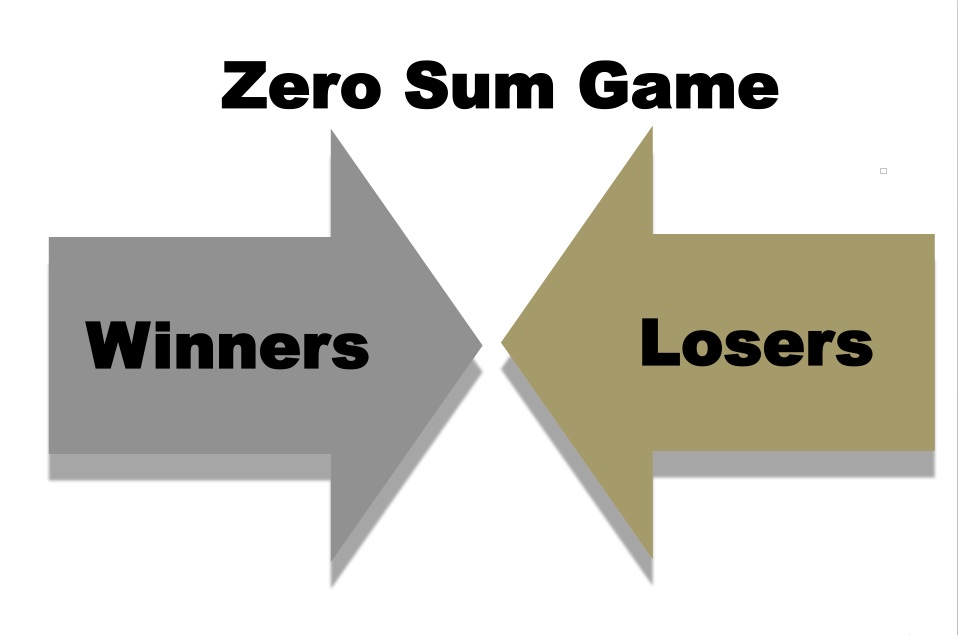In game theory, the zero-sum game is a mathematical representation of a situation in which each participant’s gain or loss of utility is exactly balanced by the losses or gains of the utility of the other participants.
In other words, whatever one person gains in utility, someone else loses an equal amount.
The term “zero-sum game” comes from the fact that the total amount of utility in the game (the sum of everyone’s utilities) is always zero. This is because for every gain in utility, there must be an equal loss in utility.
Learning about zero-sum game concept can help us make informed decisions in many facets of life. In this article, we will share real world examples of situations that model the zero sum game idea.
Let’s begin with a few basics…
Game Theory
Essentially, the zero sum game concept is part of Game Theory, which is a theoretical framework that’s often applied for reaching optimal decision making in social situations with competing parties.
The dominant strategy in Game Theory is often for one party to make the most beneficial choice although the best response is to cooperate to ensure that all participants get most beneficial, symmetric outcome.
The theory is applicable to any situation with competing parties and where there are known payoffs or quantifiable outcomes or consequences.
The theory can help the competing parties establish the most likely outcomes while paying attention to choices and actions of other parties which may affect the result.
Game theory assumes that the participants are rational and will strive to optimize their outcomes in the game.
The theory can be applied in a wide range of fields—from economics, business, psychology, evolution, to war and politics among others.
Zero Sum Game Vs. Non-Zero Sum Game
The zero-sum game is a contrast to the non-zero-sum game, in which the total amount of utility in the game can be greater than or less than zero.
In other words, while zero-sum game often ends with a net gain of zero (with one team winning and the other losing), non zero-sum game may produce a net positive or loss.
In non zero-sum game situations, there is no universally accepted solution i.e there is no single strategy that can work for all parties, nor is there a practicable outcome.
Additionally, non zero-sum games aren’t strictly competitive like zero-sum games—there are both competitive and cooperative elements to them.
That is, one party’s win does not necessarily translate to another party’s loss and vice versa. All parties could gain or lose.
Learn more here: 8 Non-Zero Sum Game Examples in Real Life
Real World Zero Sum Game Examples
Here are some of the most common real-world situations that can be modeled as zero sum games:
1. Business Competition

In business, companies are always trying to get ahead of the competition. They want to be the market leader in their industry, with the biggest market share and the most profits.
This can often lead to a zero-sum game, where one company’s gain is another company’s loss.
For example, if Company A launches a new product and it is successful, then Company B’s sales might suffer as a result.
This is especially true if the two companies are in the same niche and are competing for the same market segment.
A good example of this is the smartphone market, where Apple’s gain might also mean Samsung’s loss.
2. Political Campaigns

Political campaigns can also be seen as a zero-sum game. This is because there are only two outcomes in an election—one candidate wins and the other loses.
Even in a disputed election, where both candidates claim victory, only one can be declared the winner.
A good illustration is the Biden Vs. Trump election in 2020. Even though Trump didn’t accept the outcome, there could only be one winner and in this case, it was president Biden.
This may explain why politics is often described as a “winner-takes-it-all” competition by political scientists.
3. Arms Races

An arms race is another example of a zero-sum game. This is when two or more countries compete to build up their military forces, in a race to gain superiority over the other.
It can often lead to an escalation of tension and conflict, as each side tries to outdo the other.
When all is said and done, there can only be one country that is superior to the rest, and thus only one winner in the arms race.
A classic example is the arms race between the United States and the Soviet Union during the Cold War.
Arms race is often seen as one of the main contributing factors to the tension and conflict of that time.
It might well be the reason why the two countries have always been at loggerheads even to date.
4. Stock Market

The stock market has approximately 50/50 odds, which means that there is an equal chance of making a profit or a loss.
Some may argue that it is not a zero-sum game because the overall value of the market can increase, even if some individual stocks go down in value.
But if you look at it from the participant’s point of view, then it will be a great example of a zero sum game because for every buyer there has to be a seller and vice versa.
For example, if you buy shares in a company, then someone else has sold those shares to you. This means that their gain is your loss and vice versa.
To give you a clearer idea, let’s look at the following two popular trading options:
A. Futures Trading
Futures refer to financial contracts that necessitate participants to buy or sell assets at a set future date and price.
The seller must sell the asset at a predetermined price while the buyer must buy the same item for the price regardless of the expiration date and current market price.
The assets include financial instruments like cryptocurrencies and physical commodities such as oil, coffee, and soybean.
The speculators essentially bet on the future price of the underlying asset.
If they imagine that the price will go up, they will start buying it. When the price goes up, they sell the item at the booked price as long as the contract hasn’t expired.
This results in profit for them and loss for someone else.
B. Options Trading
Options are related to futures in that both are financial contracts.
However, the latter gives buyers (known as option holders) the right to purchase or sell a security at a price of their choice at a point in the future.
Sellers charge option buyers an amount referred to as the premium for such a right.
If market prices favor option holders, they will not exercise the right to minimize potential losses.
However, if market prices are good for them, they make use of the right for profit.
Eventually, one party wins, and another losses money.
5. Divorce

Divorce can also be considered as a zero-sum game because when a couple gets divorced, there can only be one winner and one loser.
For example, if one spouse gets the house in the divorce settlement, then the other spouse has lost out.
Similarly, if one spouse gets full custody of the children, then the other spouse has lost out in that respect.
Whichever way it goes, one party will always feel shortchanged in the settlement. This might explain why divorce is often seen as a win-lose proposition because both sides usually end up feeling like they have lost something, even if they have also gained something.
Additionally, the kids will be innocent victims of the divorce which means not only do the parents lose but the kids as well.
6. War

War is another example of a zero-sum game because in war, one side’s victory is always the other side’s defeat.
For example, in the Second World War, the Allied Powers (including the UK, the US, and the Soviet Union) defeated the Axis Powers (including Nazi Germany, Italy, and Japan).
In this example, the Allied Powers’ victory was the Axis Powers’ defeat. In other words, one side’s gain was the other side’s loss.
Granted, there are no winners in war because every country that participated in the world war suffered greatly in terms of loss of life and destruction of property.
However, the nations that were defeated in the war suffered way more than those that prevailed.
7. Negotiations

Negotiations can also be seen as a zero-sum game because, in any negotiation, there can only be one winner and one loser.
For example, if you are negotiating a salary raise with your boss and you succeed in getting what you want, then your boss has lost out and vice versa.
This would explain why in a business context, negotiation is often seen as a win-lose proposition because one side always has to concede something for the other side to gain.
If the two negotiating sides take hardline positions, then the negotiations will stall.
One or both parties must be willing to cede some ground for any agreement to be reached.
8. Gambling

Gambling is another example of a zero-sum game.
In gambling, one person’s winnings are always equal to the other person’s losses.
When two people gamble against each other, one person’s gain is always equal to the other person’s loss.
But the same applies to the entire gambling industry which involves millions of participants.
In such a scenario, the loss of a gambler is a win for the gambling industry and vice versa.
To tilt the scales in their favor, the gambling industry often resorts to unscrupulous methods which is why gambling is often seen as a rigged game.
9. Games

A number of games that we play in our day-to-day lives can also be considered to model the zero sum game concepts. This is because there is always a winner and loser, and the total payoff always sums to zero.
I. Coin Flip
The simplest and most well-known example of a zero-sum game is two people playing a coin flip, where one person wins the other person’s dollar if they call heads and lose their dollar if they call tails.
It doesn’t matter what strategies the two people use; the bottom line is one person will always win one dollar and the other person will always lose one dollar.
Therefore, the total amount of money in the game stays constant at zero.
To put it simply, a coin flip is a zero-sum game because the total amount of money gained by the winners equals the total amount of money lost by the losers.
II. Rock, Paper, Scissors
Rock, paper, scissors is another example of a zero-sum game.
In this game, each player has two possible choices: rock, paper, or scissors.
If both players choose the same option, then the game is a draw and no one wins or loses.
If one player chooses rock and the other player chooses paper, then the player who chose paper wins.
If one player chooses rock and the other player chooses scissors, then the player who chose rock wins.
And finally, if one player chooses scissors and the other player chooses paper, then the player who chose scissors wins.
In every other case, one player will win and the other player will lose. Therefore, the total amount of money in the game always stays at zero.
III. Nim
Nim, a mathematical game of strategy is an ancient game that tests your knowledge of addition.
The traditional version is played by placing several coins in heaps. The number of heaps is determined by each player.
When it’s your turn to play, you have the freedom to choose the number of coins from one heap as long as you take at least one coin from a single heap.
The player with the last move without any coins is the winner.
Other types of the game are based on the winner avoiding taking the last coin in the heap.
The game doesn’t rely on luck but rather a prediction of the best sequence of moves.
IV. Chess
Chess has simple rules and can be enjoyed by every skill level. It inspires focus, concentration, and happiness in both players no matter the outcome.
The board game is essentially played by two opponents.
The checkerboard consists of two colors – black and white.
The white is moved first after which the opponents take alternate turns to move the pieces.
The goal is to force the other player’s principal piece – the King into the valued checkmate position where he’s safe from capture.
V. Tic-tac-toe
Tic-tac-toe is an easy two-player game that always results in a tie if played optimally by the opponents.
Traditionally, the game is drawn on paper but these days it can also be played on the computer.
The simple version of the game is played on a 3×3 square grid but the advanced versions go up to 20×20 grids.
The goal of each player is to be the first to get the Xs or Os in a row vertically, horizontally, or diagonally.
If all squares are filled without either player placing the Xs or Os in a row, the game ends in a draw.
Either way, the end result is zero-sum.
VI. Bridge
Last but not least, Bridge is yet another awesome example of a zero-sum game.
The game is played by four players in two partnerships.
A pack of 52 cards is utilized in a board of 4 suits; each suit contains 13 cards with the Ace being the highest.
The dealer shares 13 cards with each player, one card at a time with each card facing down.
Each partnership tries to score points by bidding or defeating the opponent.
In the end, the partnership with the most points is declared the winner.
Summary
In summary, a zero sum game is one in which one person’s gain always equals another person’s loss.
There are many examples of zero sum game situations, some of which are more heartrending than others.
In some cases, such as in gambling, the zero sum game can be rigged in favor of one party. This often leads to the exploitation of the participants.
In other cases, such as in war, the zero sum game can lead to great suffering and even loss of life.
Either way, zero sum games are a part of our everyday lives.

